Introduction to Trigonometry - NCERT Questions
In ΔABC , right-angled at B , AB = 24 cm,
BC = 7 cm. Determine :
(i) sin A , cos A (ii) sin C , cos C
Soln. : In right angle ΔABC, we have AB = 24 cm, BC = 7 cm

∴ Using Pythagoras theorem, AC2 = AB2 + BC2
⇒ AC2 = 242 + 72 = 576 +49 = 625 = 252
⇒ AC = 25 cm
(i) 

(ii)  ,
, 
In the figure, find tan P - cot R .

Soln. : In right angle ΔPQR
Using the Pythagoras theorem, we get
QR2 = PR2 - PQ2
⇒ QR2 = 132 - 122 = (13 - 12)(13 + 12)
= 1 × 25 = 25
 cm
cm
Now,  ,
, 

If  calculate cos A and tan A .
calculate cos A and tan A .
Soln. : Let us consider, the right ΔABC, we have
Perpendicular = BC and 
Hypotenuse = AC

Let BC = 3k and AC = 4k

= (4k)2 - (3k)2 = (4k - 3k)(4k + 3k) = k(7k) = 7k2





Given 15 cot A = 8, find sin A and sec A .
SOLUTION:Soln. : In the right triangle ABC, we have
15 cot A = 8 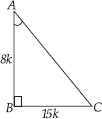



∴ AB = 8k and BC = 15k
Now, using Pythagoras theorem, we get
AC2 = AB2 + BC2
= (8k)2 + (15k)2 = 64k2 + 225k2 = 289k2 = (17k)2
⇒ AC = 


Given sec θ =  calculate all other trigonometric ratios.
calculate all other trigonometric ratios.
Soln. : In right ΔABC, ∠ B = 90° 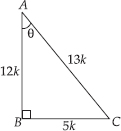
Let ∠ A = θ and sec θ = 

⇒ AC = 13k and AB = 12k
∴ Using Pythagoras theorem, we get
BC2 = AC2 - AB2
⇒ BC2 = (13k)2 - (12k)2
= (13k - 12k) (13k + 12k)
= k(25k) = 25k2 = (5k)2







If ∠ A and ∠ B are acute angles such that cos A = cos B , then show that ∠ A = ∠ B .
SOLUTION:Soln. : Let us consider a right ΔABC, ∠ C = 90°
Now, cos A = 
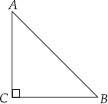
And 
Since, cos A = cos B

Now, in the ΔABC, two sides AC and BC are equal. [Proved above]
∴ Their opposite angles are also equal.
∴ ∠ A = ∠ B.
If cot θ =  evaluate:
evaluate:
(i)  (ii) cot 2θ
(ii) cot 2θ
Soln. : In right ΔABC, ∠ B = 90° and ∠ A = θ
 .......(1) [Given]
.......(1) [Given]
But in right ΔABC, cot θ =  .......(2)
.......(2)
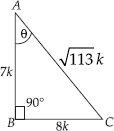
From (1) and (2), 
⇒ AB = 7k and BC = 8k
∴ AC2 = AB2 + BC2 = (7k)2 + (8k)2
(Pythagoras theorem)



Now,
(i) 
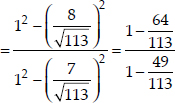

(ii) 
If 3 cot A = 4, check whether

Soln. : In right angled ΔABC, ∠ B = 90°
∴ For ∠ A, we have:
Base = AB and perpendicular = BC. Also
Hypotenuse = AC
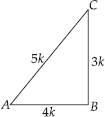
∴ 3 cot A = 4
∴ cot A = 4/3 ...(1)
But cot A  ...(2)
...(2)
∴ From (1) and (2), 
⇒ AB = 4k and BC = 3k
∴ Using Pythagoras theorem, we get
AC2 = AB2 + BC2
⇒ AC2 = (4k)2 + (3k)2


Now, 


Now, to check the given equation,
L.H.S. = 

 ........(i)
........(i)
R.H.S. = cos2A - sin2A

 .........(ii)
.........(ii)
From (i) and (ii), we have L.H.S. = R.H.S.

In triangle ABC , right angled at B , if tan A = 
find the value of :
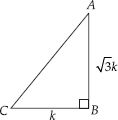
(i) sin A cos C + cos A sin C
(ii) cos A cos C - sin A sin C
Soln. : In right ΔABC, ∠ B = 90°
For ∠ A, we have
Base = BC, Perpendicular = AB,
Hypotenuse = AC
 .......(1) (Given)
.......(1) (Given)
∴ tan A  ........(2)
........(2)
From (1) and (2), we have

⇒ AB =  and BC = 1k
and BC = 1k
Now, using Pythagoras theorem, we get
AC2 = AB2 + BC2


Now,  ,
,

Again, for ∠ C, we have
Base = BC, Perpendicular = AB
and Hypotenuse = AC
 ,
,

(i) 

(ii) 

In ΔPQR , right-angled at Q , PR + QR = 25 cm and PQ = 5 cm. Determine the values of sin P , cos P and tan P .
SOLUTION:
Soln. : In right ΔPQR, Q = 90°
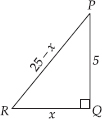
PR + QR = 25 cm and PQ = 5 cm
Let QR = x cm ⇒ PR = (25 - x)
∴ By Pythagoras theorem, we have
PR2 = QR2 + PQ2
⇒ (25 - x)2 = x2 + 52
⇒ 625 - 50x + x2 = x2 +25
⇒ - 50x = - 600
⇒  i.e., RQ = 12 cm
i.e., RQ = 12 cm
⇒ RP = 25 - 12 = 13 cm
Now,  ,
,  ,
,

State whether the following are true or false. Justify your answer.
(i) The value of tan A is always less than 1.
(ii) sec A =  for some value of angle A .
for some value of angle A .
(iii) cos A is the abbreviation used for the cosecant of angle A .
(iv) cot A is the product of cot and A .
(v)  for some angle θ.
for some angle θ.
Soln. : (i) False [∵ A tangent of an angle is ratio of sides other than hypotenuse, which may be equal or unequal to each other.]
(ii) True [∵ cos A is always less than 1]
 i.e., sec A will always be greater
i.e., sec A will always be greater
than 1
(iii) False [∵ 'cosine A' is abbreviated as 'cos A']
(iv) False ['cot A' is a single and meaningful term whereas 'cot' alone has no meaning.]
(v) False [ is greater than 1 and sinθ cannot be greater than 1]
is greater than 1 and sinθ cannot be greater than 1]
Evaluate the following:
(i) sin60° cos30° + sin 30° cos 60°
(ii) 2tan 2 45° + cos 2 30° - sin 2 60°
(iii) 
(iv) 
(v) 
Soln. : (i) sin 60° cos 30° + sin 30° cos 60°





(ii) 2tan2 45° + cos2 30° - sin2 60°





(iii) 







(iv) 

and cot 45° = 1








(v) 
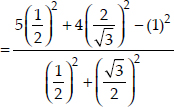


Choose the correct option and justify your choice:
(i) 
(A) sin 60° (B) cos 60°
(C) tan 60° (D) sin 30°
(ii) 
(A) tan 90° (B) 1
(C) sin 45° (D) 0
(iii) sin 2 A = 2sin A is true when A =
(A) 0° (B) 30°
(C) 45° (D) 60°
(iv) 
(A) cos 60° (B) sin 60° (C) tan 60° (D) sin 30°
Soln. : (i) (A) 


(ii) (D) : 

(iii) (A) : When A = 0, then
sin 2A = sin 2(0°) = sin 0° = 0,
2 sin A = 2 sin 0° = 2 × 0 = 0
i.e., sin 2A = 2sin A for A = 0°
(iv) (C) : 


If tan ( A + B ) =  and tan ( A - B ) =
and tan ( A - B ) = 
0° < A + B < 90°; A > B , find A and B.
Soln. : We have,
tan 60°  , tan 30° =
, tan 30° =  ......(1)
......(1)
Also tan (A + B)  and tan (A - B)
and tan (A - B)  (Given)
(Given)
.......(2)
From (1) and (2), we get A + B = 60° and
A - B = 30°
On adding A + B and A - B, we get 2A = 90°
⇒ A = 45°
On subtracting A + B and A - B, we get 2B = 30°
⇒ B = 15°
State whether the following are true or false. Justify your answer.
(i) sin ( A + B ) = sin A + sin B .
(ii) The value of sin θ increases as θ increases.
(iii) The value of cos θ increases as θ increases.
(iv) sin θ = cos θ for all values of θ .
(v) cot A is not defined for A = 0°.
Soln. : (i) False : Let us take A = 30° and B = 60°, then L.H.S = sin (30° + 60°) = sin 90° = 1
R.H.S.= sin 30° + sin 60°

∴ L.H.S. ≠ R.H.S.
(ii) True : Since the values of sin θ increases from 0 to 1 as θ increases from 0 to 90°.
(iii) False : Since the value of cos θ decreases from 1 to 0 as θ increases from 0 to 90°.
(iv) False : Let us take θ = 30°

⇒ sin 30° ≠ cos 30°
(v) True : We have cot 0° = not defined
Evaluate:
(i)  (ii)
(ii) 
(iii)  (iv)
(iv) 
Soln. : (i) 
⇒ sin 18° = sin (90° - 72°) = cos 72°
[∵ sin (90° - A) = cos A]
∴ 
(ii) 
tan 26° = tan (90° - 64°) = cot 64° [∵ tan (90° - A) = cot A]

(iii) cos 48° - sin 42°
cos 48° = cos (90° - 42°) = sin 42° [∵ cos (90° - A) = sin A]
∴ cos 48° - sin 42° = sin 42° - sin 42° = 0
(iv) cosec 31° - sec 59°
cosec 31° = cosec (90° - 59°) = sec 59° [∵ cosec (90° - A) = sec A]
∴ cosec 31° - sec 59° = sec 59° - sec 59° = 0
Show that:
(i) tan 48° tan 23° tan 42° tan 67° = 1
(ii) cos 38° cos 52° - sin 38° sin 52° = 0
Soln. : (i) tan 48° tan 23° tan 42° tan 67° = 1
L.H.S. = tan 48° tan 23° tan 42° tan 67°
= tan (90° - 42°) tan 23° tan 42° tan (90° - 23°)
[Q tan (90° - A) = cot A]
= cot 42° tan 23° tan 42° cot 23°



∴ L.H.S. = R.H.S.
(ii) cos 38° cos 52° - sin 38° sin 52° = 0
L.H.S. = cos 38° cos 52° - sin 38° sin 52°
= cos 38° cos (90° - 38°) - sin 38° sin (90° - 38°)
= cos 38° sin 38° - sin 38° cos 38°
[∵ sin (90° - A) = cos A and cos (90° - A)= sin A]
= 0 = R.H.S.
∴ L.H.S. = R.H.S.
If tan 2 A = cot ( A - 18°), where 2 A is an acute angle, find the value of A .
SOLUTION:
Soln. : Since tan 2A = cot (A - 18°)
Also tan (2A) = cot (90° - 2A)
[∵ tan θ = cot (90° - θ)]
⇒ A - 18° = 90° - 2A
⇒ A + 2A = 90° + 18°
⇒ 3A = 108° ⇒ 
If tan A = cot B , prove that A + B = 90°
SOLUTION:
Soln. : tan A = cot B and cot B = tan (90° - B)
∴ A = 90° - B ⇒ A + B = 90°
[∵ tan (90° - θ) = cot θ]
If sec 4 A = cosec ( A - 20°), where 4 A is an acute angle, find the value of A.
SOLUTION:
Soln. : ∵ sec 4A = cosec (A - 20°)
sec (4A) = cosec (90° - 4A)
[∵ cosec (90° - θ) = sec θ]
∴ A - 20° = 90° - 4A
⇒ A + 4A = 90° + 20°
⇒ 5A = 110° ⇒ A = 
If A , B and C are interior angles of a triangle ABC , then show that 
Soln. : Since, sum of the angles of ΔABC is
A + B + C = 180°
∴ B + C = 180° - A
Dividing both sides by 2, we get


 [∵ sin (90° - θ) = cos θ]
[∵ sin (90° - θ) = cos θ]

Express sin 67° + cos 75° in terms of trigonometric ratios of angle between 0° and 45°.
SOLUTION:
Soln. : Since sin 67° = sin (90° - 23°) = cos 23°
[∵ sin (90° - θ ) = cos θ]
Also, cos 75° = cos (90° - 15°) = sin 15°
[∵ cos (90° - θ) = sin θ]
∴ sin 67° + cos 75° = cos 23° + sin 15°
Express the the trigonometric ratios sin A ,
sec A and tan A in terms of cot A.
Soln. : (a) sin A 


(b) 

(c) 
Write all the other trigonometric ratios of ∠ A in terms of sec A.
SOLUTION:Soln. : (i) sin A = 



(ii) 
(iii) 

(iv) 

(v) 
Evaluate :
(i) 
(ii) 
Soln. : (i) 
∵ sin 63° = sin (90° - 27°) = cos 27°
⇒ sin2 63° = cos2 27°
cos2 73° = cos2 (90° - 17°) = sin2 17°
 = 1
= 1
[∵ cos2A + sin2A = 1]
(ii) sin 25° cos 65° + cos 25° sin 65°
∵ sin 25° = sin (90° - 65°) = cos 65°
[∵ sin (90° - A) = cos A]
cos 25° = cos (90° - 65°) = sin 65°
[∵ cos (90° - A) = sin A]
∴ sin 25° cos 65° + cos 25° sin 65°
= cos 65° cos 65° + sin 65° sin 65°
= (cos 65°)2 + (sin 65°)2
= cos2 65° + sin2 65° = 1 [∵ cos2 A + sin2 A = 1]
Choose the correct option. Justify your choice.
(i) 9 sec 2 A - 9 tan 2 A = .................
(A) 1 (B) 9
(C) 8 (D) 0
(ii) (1 + tan θ + sec θ ) (1 + cot θ - cosec θ ) = ...................
(A) 0 (B) 1
(C) 2 (D) - 1
(iii) (sec A + tan A ) (1 - sin A ) = .......................
(A) sec A (B) sin A
(C) cosec A (D) cos A
(iv)  .........................
.........................
(A) sec 2 A (B) - 1
(C) cot 2 A (D) tan 2 A
Soln. : (i) (B) : Since, 9 sec2 A - 9 tan2 A
= 9 (sec2 A - tan2 A) = 9 (1) = 9
[∵ tan2 A + 1 = sec2 A ⇒ sec2 A - tan2A = 1]
(ii) (C) : Here, (1 + tan θ + sec θ) (1 + cot θ - cosec θ)
= (1 + tan θ + sec θ) 
= (1 + tan θ + sec θ) 





 = 2
= 2
(iii) (D) : We have : (sec A + tan A) (1 - sin A)


 = cos A
= cos A
(iv) (D) : Here, 
 = tan2 A
= tan2 A
Prove the following identities, where the angles involved are acute angles for which the expressions are defined.
(i) (cosec θ - cot θ ) 2 = 
(ii) 
(iii) 
[Hint : Write the expression in terms of sin θ and cos θ ]
(iv)  [Hint : Simplify L.H.S. and R.H.S. separately]
[Hint : Simplify L.H.S. and R.H.S. separately]
(v)  = cosec A + cot A , using the identity cosec 2 A = 1 + cot 2 A .
= cosec A + cot A , using the identity cosec 2 A = 1 + cot 2 A .
(vi) 
(vii) 
(viii) (sin A + cosec A ) 2 + (cos A + sec A ) 2
= 7 + tan 2 A + cot 2 A
(ix) (cosec A - sin A ) (sec A - cos A )

[Hint : Simplify L.H.S. and R.H.S. separately]
(x) 
Soln. : (i) L.H.S = (cosec θ - cot θ)2


 [∵ sin2 θ = 1 - cos2 θ]
[∵ sin2 θ = 1 - cos2 θ]

[∵ 1 - cos2 θ = (1 - cos θ) (1 + cos θ)]

Hence, L.H.S. = R.H.S.
(ii) L.H.S. 



 [∵ cos2 A + sin2 A = 1]
[∵ cos2 A + sin2 A = 1]


 = R.H.S
= R.H.S 
Hence, L.H.S. = R.H.S.
(iii) L.H.S. 







 [∵ sin2 θ + cos2 θ = 1]
[∵ sin2 θ + cos2 θ = 1]


= cosec θ sec θ + 1 = 1 + sec θ·cosec θ
= R.H.S.
(iv) 

 [Multiplying and dividing by (1 - cos A)]
[Multiplying and dividing by (1 - cos A)]

 = R.H.S. [∵ 1 - cos2 A = sin2 A]
= R.H.S. [∵ 1 - cos2 A = sin2 A]
(v) L.H.S. 
 [Dividing each term of num. and den. by sin A]
[Dividing each term of num. and den. by sin A]

 [Multiplying and dividing by (cot A + cosec A)]
[Multiplying and dividing by (cot A + cosec A)]




[∵ cot2 A - cosec2 A = - 1]
= cot A + cosec A = R.H.S.
(vi) L.H.S. 
 [Multiplying and dividing by (cot A + cosec A)]
[Multiplying and dividing by (cot A + cosec A)]
 [∵ (1 - sin A) (1 + sin A)
[∵ (1 - sin A) (1 + sin A)
= 1 - sin2 A]
 [∵ 1 - sin2 A = cos2 A]
[∵ 1 - sin2 A = cos2 A]


= sec A + tan A = R.H.S.
(vii) 



(viii) L.H.S. = (sin A + cosec A)2 + (cos A + sec A)2
= sin2 A + cosec2 A + 2 sin A·cosec A + cos2 A
+ sec2 A + 2 cos A·sec A
= (sin2 A + cos2 A) + cosec2 A + sec2 A + 2 + 2
[sin A·cosec A = 1 and sec A·cos A = 1]
= 1 + cosec2 A + sec2 A + 4
[∵ sin2 A + cos2 A = 1]
= 5 + (1 + cot2 A) + (1 + tan2 A)
[∵ cosec2 A = 1 + cot2 A and sec2 A = 1 + tan2 A]
= 7 + cot2 A + tan2 A = R.H.S
(ix) L.H.S. = (cosec A - sin A) (sec A - cos A)


 [∵ 1 - sin2 A = cos2 A
[∵ 1 - sin2 A = cos2 A
and 1 - cos2 A = sin2 A]
= sin A·cos A


[∵ 1 = sin2 A + cos2 A]
 [Dividing num. and den. by sin A cos A]
[Dividing num. and den. by sin A cos A]

(x) 


= tan2 A = R.H.S. ...(1)



= (-tan A)2 = tan2A = R.H.S. ...(2)
∴ From (1) and (2), we get
